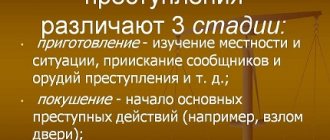Characteristic
Plurality of crimes in Russian criminal law is interpreted as the commission of several crimes by one person. The main condition in this situation is that each criminal offense is an independent offense and also retains legal significance.
There is no article in the legislation that defines this term. This concept is of a criminal law nature and is applied in practice. With its help, the commission of several illegal actions by a person is reflected to an adequate extent. In this situation, it does not matter what the composition is, or whether the culprit was brought to justice.
Qualitative and quantitative criteria that are included in the understanding of plurality influence qualifications.
The legislator also indicates individual appointment, which is discussed in many course works. A difficult question is raised regarding the appointment and execution of punishments and the consequences of them. To solve them, it is necessary to establish the category in question.
Plurality has the following characteristics:
- the criminality of the actions committed by a person is provided for by one or more articles or chapters of the code;
- the multiplicity of crimes, its concept and types indicate that the offenses have signs of independence;
- the variety of compositions ensures that each of them retains its consequences.
Consultants point out that in practice it is necessary to distinguish the concept in question from related ones. This would mean that plurality has certain characteristics.
Assignment of punishment based on cumulative sentences
The concept of cumulative sentences refers to the types of multiplicity of criminal acts. Considering the content of this concept, you can see that it is impossible for it to cover repetition, aggregates or relapse.
The lack of a precise definition in the legislation entails ambiguity in the selection of rules within the boundaries of which the choice of punishments is carried out.
It is generally accepted that a set of sentences means the commission of a new crime by a person, which, according to the time criterion, corresponds to the period of time lasting after the pronouncement of the sentence, but limited to the full serving of the sentence under this sentence.
In the presence of such circumstances, the application of the rule of absorption by a more severe punishment of a less severe punishment does not apply.
Author of the article
The concept of a single crime
A single (single) crime is an act that constitutes an unlawful offense and is covered by the elements of one crime. If the actions of an attacker affect several parts of the Criminal Code at once, this is a reason to talk about multiple offenses, which means several crimes.
Single crimes are divided into several fundamental groups:
- Simple crimes. Here there is one formal corpus delicti, containing one criminal act, one object and one form of guilt. Consequently, all acts committed by one offender are combined into a single crime, the responsibility for which will be determined by a specific article of the Criminal Code.
- Complex composition of the criminal act. Here there is a combination of several homogeneous signs of criminal intent. This includes actions of an attacker that are not performed for the first time, the presence of several elements of a crime, as well as long-term (prolonged) criminal acts (coinciding concepts and signs of multiple crimes).
- There are two required actions. The attacker performs two independent actions that have a criminal origin. If one of the actions is not completed in full, the crime will be considered unfinished.
- Availability of alternative actions to the criminal act. This provides for the existence of an offense for which liability will consist of any measures specified in the disposition. The most striking example is Article 295 of the Criminal Code of the Russian Federation, where a criminal offense can be different - production, acquisition, transfer, sale, storage, transportation of firearms.
- Compound criminal intent. It appears through the inclusion in a separate composition of two or more crimes, each of which is separate under criminal law. At the same time, there must be certain conditions that combine atrocities into one group.
- Repeated crime. The attacker commits an unlawful offense that has already been recorded for him. Here, when determining punishment, importance will be given to the systematic nature of the crime, the presence of malicious intent and the principle of repetition.
Along with crimes of a single nature, the legislator assumes the existence of special types of unlawful acts characterized by multiple elements of a crime.
The difference between multiple crimes and single ones lies in the characteristics of qualifications.
Multiplicity of crimes: key concepts
Despite the fact that the concept of multiple crimes occurs quite often and is actively used in various situations related to jurisprudence. However, there is no definition of the concept of multiple crimes in the regulations of the criminal legislative framework.
Multiple crimes are the commission of several criminal offenses by one person, which occurred within the same time frame and are interconnected. At the same time, one of the key rules is the impossibility of taking into account those criminal acts that were committed a long time ago, and the statute of limitations for them has already passed. However, in some situations, the classification of crimes is influenced by differences in situations, as well as by the consequences that occur after the crime has been committed.
Also read: Urgent necessity in criminal law: what does it mean in simple words
The plurality of crimes is characterized by the presence of certain signs that are approved at the legislative level and are necessarily taken into account when classifying criminal acts as multiple.
Signs of plurality
The state establishes and defines the following key features of the multiplicity of crimes, the presence of which makes it possible to talk about the multiplicity of criminal atrocities.
- Commitment by one offender of several atrocities provided for by one or different articles of the Criminal Code.
The presence of this feature affects all situations where an attacker commits several criminal acts, each of which is a separate crime. As a result, for each violation a certain punishment is established, which will be determined after considering all the facts of criminal actions.
Note that the plurality of crimes should be understood as situations where there are several proven facts of atrocities. If the perpetrator is acquitted of one of the crimes, his actions are not considered illegal, liability does not arise according to the criminal profile (administrative fine, disciplinary punishment, civil tort).
- Each of the crimes forms a single form, being independent. As a consequence, the classification of atrocities is carried out under separate articles (parts of one article).
Each of the offenses committed by one offender is a separate act, having all forms of illegality and the specific legal meaning of a plurality of crimes. At the same time, all the crimes committed are combined with each other, which allows us to talk about the existing multiplicity of crimes. Each of the actions, which together form the parameter of multiplicity, can be either completed or incomplete.
An interesting nuance is that if a criminal is convicted of participating in a criminal act again, plurality will be established regardless of whether he independently organized the crime or took part as an intermediary or accomplice. The fact of the unlawful act itself will be important.
- Each of the atrocities that together form a plurality of crimes retains the criminal legal consequences of the plurality of crimes that arise as a result of the commission of an illegal act.
Each of the crimes committed retains all the consequences outlined in government regulations, as well as the concepts and forms of multiple crimes in criminal law. Consequently, despite the plurality, any penalty affecting his crime can be applied to the offender. So, the following points can be attributed to this situation:
- expungement of a criminal record carried out on the basis of existing acts of amnesty or pardon (Articles 84, 85 of the Criminal Code of the Russian Federation), fulfillment of the conditions for expungement of a criminal record (Article 86);
- release from criminal proceedings due to sincere repentance, cooperation with investigative authorities, as well as on the basis of an act of amnesty or pardon;
- release of a criminal from serving a sentence due to serious illness, expiration of the statute of limitations, or the imposition of a sentence such as a suspended sentence.
- The presence of criminal intentions is reflected in key criminal procedural documentation provided by the investigative authorities, or in the guilty verdict of the court.
The Social Essence of Plurality
Multiple crimes is a situation when one attacker sequentially, or by one action (inaction), commits two or more crimes related to one article of the Criminal Code, or which are separate independent crimes.
Speaking about such a concept as plurality, its social essence is established. It will consist in the fact that the fulfillment of several criminal intentions by one person indicates his social disunity, inability (unwillingness) to contact society and follow established rules and norms, as well as the presence of a stable antisocial life position.
In addition, the very fact of multiplicity casts doubt on the possibility of committing atrocities unintentionally, under the influence of circumstances or third parties. From the point of view of society, the fact that the attacker has criminal professionalism will be established.
As a rule, any crime directed against the public is accompanied by damage to society, as well as to the norms and rules of a moral and ethical nature established by it. Speaking about the social essence of plurality, we must also pay attention to the fact that the very presence of conditions for the commission of several malicious actions indicates the presence of problems in society. Thus, problems of multiplicity of crimes indicate shortcomings in the work of operational and law enforcement services, and establish shortcomings in the control of potentially dangerous citizens.
Assignment of punishments for a set of crimes
Conclusions about a person's guilt can only be made by a court. The act of justice that determines the punishment of the guilty person is the sentence. Punishment or release from it is the result of justice. In the process of determining the measure and amount of punishment, the court uses the provisions of the General Part of the Criminal Code, namely Art. 60.
A set of crimes that were committed by a single entity is subject to consideration in one trial. Of particular importance is the use by justice of general and sectoral principles that must be followed when choosing a punishment.
The presence of signs of criminality in a person’s actions can only be established on the basis of the Criminal Code. It is strictly prohibited to allow an analogy of the law in these cases.
The procedure for imposing punishments for two or more crimes is determined by the criminal law system, which had significant differences at different historical stages of the industry’s existence.
The current Criminal Code establishes a provision according to which the court imposes separate punishments for each individual criminal act, if a person has committed several crimes.
The process of applying population rules has two stages. At the first stage, the punishment is determined in relation to each individual act, and at the second, a cumulative punishment is assigned, which is recognized as final.
The presence of such stages is the fundamental basis for imposing a general punishment, with a mandatory determination of the scope of responsibility in relation to each of the acts.
Responsibility measures provided for in the form of punishments can absorb each other or be combined. In addition, the court has the right to impose a primary punishment for one act, and an additional one for the second, which is characterized by a low level of public danger.
Forms and types of multiplicity of crimes
The question of forms (types) of plurality of crimes in the doctrine of criminal law is interpreted ambiguously. Before amendments were made to the Criminal Code by Federal Law No. 162-FZ of December 8, 2003 “On Amendments and Additions to the Criminal Code of the Russian Federation,” it was believed that the plurality of crimes finds its concrete manifestation in the repetition (multiple occurrence) of crimes, their aggregate and recidivism.
Also read: What is a suspended sentence and in what cases is it imposed?
The scientific position of the author of this chapter on the issue under consideration is set out in the monograph “The totality of crimes (issues of qualification and sentencing)”, published in 1974 by the Kazan University Publishing House, and in subsequent publications. When identifying forms of plurality, the author took not a legal criterion (one or more articles of the Criminal Code qualify the act, whether the person was convicted or not), but a social one - the actual behavior of a person when committing two or more crimes: whether the commission of multiple criminal acts is associated with a sign of their repetition.
When committing many crimes associated with their repetition, in the mental activity of a person, as a rule, there is a struggle between socially approved and socially condemned motives, and the commission of criminal acts again and again is evidence that socially condemned motives and views each time for this subject turn out to be a priority, prevailing over socially approved motives. This circumstance indicates the stability of socially condemned views, needs and motives of a given person, his great socio-psychological neglect, i.e. to increased public danger.
In the mental activity of a person, when he makes a decision to commit two or more crimes with one action and decision, there is no repetition of the struggle of motives. Based on this, it was concluded that the multiplicity of crimes finds its concrete manifestation in two of its forms: in the repetition (repetition) of crimes and their ideal totality.
The current Criminal Code gives reason to believe that it provides for five types of multiple crimes:
- set of crimes;
- the commission of two or more crimes provided for in the articles of the Special Part of the Criminal Code as a circumstance entailing a more severe punishment;
- relapse of crimes;
- aggregation of sentences and the commission of a new crime in the presence of a criminal record that is not taken into account when recognizing a recidivism.
The above types of multiplicity of crimes in criminal law have their own characteristics, criminal legal and criminal procedural consequences. Each of these types of multiplicity of crimes is composed of single crimes. Therefore, let us first consider the question of the essence and types of individual crimes.
Real and ideal set of crimes
A set of crimes can form crimes committed by one or different actions, either at different times or simultaneously. In this regard, two types of aggregate crimes are distinguished: real and ideal aggregate.
Real totality of crimes
The totality is recognized as real when a person commits two or more crimes under different articles or parts of an article of the Criminal Code at different times by different independent acts. For example, the perpetrator commits murder (Article 105 of the Criminal Code of the Russian Federation), and then after some time commits robbery (Article 162 of the Criminal Code of the Russian Federation). In a real totality, there is a period of time between crimes (it doesn’t matter whether it’s long or short). One of them in relation to the other will always be the first in terms of the time of its commission. At the same time, in relation to the first (subsequent) crime, the statute of limitations for bringing to criminal liability must not expire (Article 78 of the Criminal Code of the Russian Federation). For example, committing a premeditated murder after the end of a violent sexual act or an attempt on it in order to conceal the crime committed forms a set of relevant crimes (clause 13 of the Resolution of the Plenum of the Supreme Court of the Russian Federation of January 27, 1999 N 1 “On judicial practice in cases of murder (Article 105 Criminal Code of the Russian Federation)").
The time of commission of two or more crimes may completely coincide. Thus, the simultaneous illegal possession of weapons and drugs forms a real set of crimes, since at the time of the commission of one ongoing crime, another is committed, and both crimes continue to be committed until the state of storage ceases. The presence of a real aggregate in this case is due to the fact that outwardly almost identical storage actions are still different, since they are performed independently in relation to each item of storage. Another example: a person commits desertion (Article 338 of the Criminal Code of the Russian Federation) and at the same time illegally possesses weapons (Article 222 of the Criminal Code of the Russian Federation).
Thus, the real population is characterized by the following features:
- committing two or more independent crimes within a certain time interval;
- the person was not convicted for their commission;
- for their commission, criminal prosecution is possible (the statute of limitations for criminal prosecution has not expired, there is no act of amnesty, etc.).
The real totality consists of both completed crimes and preparation or attempted crime, as well as crimes committed in complicity.
Examples of qualification of acts as a real set of crimes
Theft and theft . If a person steals a vehicle without the purpose of stealing it (Article 166 of the Criminal Code of the Russian Federation) and at the same time steals the property located in it, the act constitutes a set of crimes providing for liability for theft and theft (clause 22 of the Resolution of the Plenum of the Armed Forces of the Russian Federation dated 09.12.2008 N 25 “On judicial practice in cases of crimes related to violation of traffic rules and operation of vehicles, as well as their unlawful taking without the purpose of theft”).
Extortion and robbery (robbery) . If extortion is associated with the direct seizure of the victim’s property, then if there is a real set of crimes, the crime is qualified under Art. Art. 163 and 161 or under Art. 162 of the Criminal Code of the Russian Federation, depending on the nature of the violence used (clause 10 of the Resolution of the Plenum of the Armed Forces of the Russian Federation dated December 17, 2015 N 56 “On judicial practice in cases of extortion (Article 163 of the Criminal Code of the Russian Federation)”).
Hooliganism and resistance to police . Hooligan actions involving resistance to a police officer, a government official or a member of the public performing duties to protect public order, or another person suppressing violations of public order, are fully covered by the disposition of Part 2 of Art. 213 of the Criminal Code of the Russian Federation. Resistance provided after the cessation of hooliganism, for example in connection with the subsequent detention of the perpetrator, forms a set of crimes provided for in Part 1 of Art. 213 of the Criminal Code of the Russian Federation and, for example, Art. Art. 317 or 318 of the Criminal Code of the Russian Federation (clause 7 of the Resolution of the Plenum of the Armed Forces of the Russian Federation of November 15, 2007 N 45 “On judicial practice in criminal cases of hooliganism and other crimes committed out of hooligan motives”).
The perfect set of crimes
An ideal set is the commission of one action (inaction) that contains signs of crimes provided for by two or more articles of the Criminal Code of the Russian Federation.
As a result of one criminal act, damage is caused to various objects protected by different articles of the Criminal Code of the Russian Federation. These objects do not relate to each other as part and whole. A criminal act is not covered by one norm, but requires qualification under various articles of the Criminal Code.
Thus, an ideal set is characterized by the following features:
- commission of one criminal act (inaction);
- the act contains signs of crimes provided for by two or more articles of the Criminal Code of the Russian Federation;
- the person has not been convicted of committing the act and criminal prosecution is possible.
For example, arson of a house and death due to arson of a person form an ideal set of crimes provided for in Art. Art. 167 and 105 or 109 of the Criminal Code of the Russian Federation, depending on the form of guilt in relation to the death of a person. Another example: the perpetrator, in order to influence the decision-making of the authorities, commits an explosion of a residential building, as a result of which the residents die and the structure is destroyed. If there is a deliberate attitude towards the consequences, his actions are subject to qualification under Art. Art. 205, 105, 167 of the Criminal Code of the Russian Federation. In fact, with one action (explosion), the person committed three crimes: an act of terrorism, murder and intentional destruction of property.
Cases of an ideal totality as a form of multiplicity are few.
The division of the totality of crimes into real and ideal is a doctrinal classification. The law provides for uniform rules for assigning punishment for a set of crimes in accordance with Article 69 of the Criminal Code of the Russian Federation.
Single (single) crimes, their types and difference from multiple crimes
Multiple crimes means the commission of two or more single crimes under the conditions specified in the law. According to Part I of Art. 14 of the Criminal Code, a crime is recognized as a socially dangerous act committed guilty of guilt, prohibited by the Criminal Code under threat of punishment. In Art. 14 is about a single crime. According to their socio-psychological and legal characteristics, individual crimes, as already mentioned, can be simple or complex.
Taking into account the changes that have occurred in criminal legislation, among complex single crimes it is necessary to distinguish between compound and continued crimes; crimes based on alternative or repeated (repeated) actions; ongoing crimes.
In the above-mentioned complex criminal acts, the preliminary investigation authorities and courts experience the greatest difficulties in giving a legal assessment of the act as a single crime or as a set of crimes. The greatest difficulty in distinguishing individual acts from their totality (multiplicity) is presented by compound and continuous crimes, as well as crimes based on alternative or repeated (repeated) actions.
Compound crimes are understood as two or more criminal acts combined by law into one complex crime, each of which, when assessed in isolation, could be considered as an independent simple crime. The literature rightly draws attention to the fact that compound crimes are nothing more than a special case of a set of crimes taken into account by law (PP Galiakbarov). Compound crimes encroach on two objects and in this way differ from simple (single-object) crimes. In the legal assessment of compound crimes as their totality taken into account by law, one should distinguish between two main types:
- compound crimes, which are based on the real totality of crimes;
- compound crimes, which are based on their ideal totality.
A type of compound crime are crimes qualified by the presence of grave consequences. Thus, kidnapping, which through negligence resulted in the death of the victim, should be regarded as a compound crime and qualified under paragraph “c” of Part 3 of Art. 126 of the Criminal Code.
The only difficult thing is the ongoing crime. Continuing crimes are understood as crimes consisting of a number of identical criminal actions aimed at a common goal and in their totality constituting a single crime. This characterization of the ongoing crime in the interpretation of the RF PVS of March 4, 1929 suffers from inaccuracy. Continuing crimes can be committed not only intentionally, but also through negligence.
Also read: What are the penalties for stealing a pet?
The peculiarity of a continuing crime is that it is committed by actions separated in time, each of which does not have the meaning of an independent crime, but represents a link or stage in the implementation of the same criminal act. Since individual acts of a continuing crime do not have the nature of an independent crime, they do not receive separate legal qualifications and are generally regarded as a single crime.
Continuing crimes should be distinguished from a set of crimes provided for in the same article of the Special Part of the Criminal Code. The difficulty of distinguishing this type of set of acts from a continuing crime lies in the fact that in their external characteristics these types of criminal activities largely coincide.
However, in a continuing crime, there is a subjective connection between individual acts of criminal actions, which is expressed in the fact that each next act of continued behavior acts as a link or stage in the person’s implementation of a single criminal intention or is a continuation of imprudent activity caused by his inexcusable mistake, for example, causing death by accident. negligence by two or more patients due to systematic improper performance by a person of his professional duties for a certain time (Part 3 of Article 109 of the Criminal Code).
Complex crimes are those based on alternative or repeated (repeated) actions: for example, illegal acquisition, storage, transportation, production, processing of narcotic drugs, psychotropic substances or their analogues (Article 228 of the Criminal Code), etc.
The peculiarity of such crimes is that the commission by a person of each of the actions named in the law is in itself sufficient to recognize the crime as completed. However, a person is not considered to have committed a new crime if he consistently carries out all the actions listed in the law. What was done in this case is qualified as a single ongoing crime, consisting of alternative actions, it does not form a plurality of crimes.
The Criminal Code provides for crimes based on repeated (repeated) actions (Article 154, Parts 1 and 2 of Article 180). Thus, the illegal use of a trademark, service mark, appellation of origin of goods or similar designations for homogeneous goods is recognized as a crime provided that this act is committed repeatedly or causes major damage.
Complex are the so-called continuing crimes, the uniqueness of which lies in the fact that they are committed (last) for a certain period of time continuously. In accordance with the explanations of the above-mentioned resolution of the PVS of the USSR dated March 4, 1929, a continuing crime is understood as an action or inaction associated with subsequent long-term failure to fulfill the obligations imposed on the perpetrator by law under the threat of criminal prosecution.
When deciding on the issue of assessing an act as a single (individual) crime or their multiplicity, one should proceed from the socio-psychological content of this criminal behavior, as well as from the description in the disposition of the article of the Criminal Code of its objective and subjective characteristics.
Distinguishing between a single crime and multiple acts
Usually, the distinction between concepts such as a single crime and multiple crimes does not cause any difficulties, since the qualification of a single crime fully covers the characteristics of one crime, provided for in one article of the Criminal Code of the Russian Federation. A single crime is an act or omission, encroaches only on one object and is committed with one form of guilt.
However, in criminal law there is such a concept as a complex single crime; it is externally similar to a plurality of crimes, since it consists of a number of homogeneous or heterogeneous actions and is a continuing or continuing crime.
A complex single act is recognized as a crime based on an alternative/repeated action, for example, Art. 228 of the Criminal Code of the Russian Federation - illegal acquisition, storage, transportation, production, processing of narcotic drugs, psychotropic substances or their analogues.
The commission by a person of each of these actions is already a sufficient basis for recognizing the crime as completed, but at the same time, the implementation of all actions together will be regarded as a single ongoing crime, without the formation of plurality. In general, criminal law distinguishes the following several types of complex single crime: continued, ongoing, composite, with two mandatory actions, with several alternatives, with two forms of guilt, with repeatedly committed actions, multi-objective, with additional severe consequences.
When resolving the issue of defining a crime as single or multiple, one should proceed from the norms of a separate article of the Code and identify the socio-psychological content of criminal behavior.









